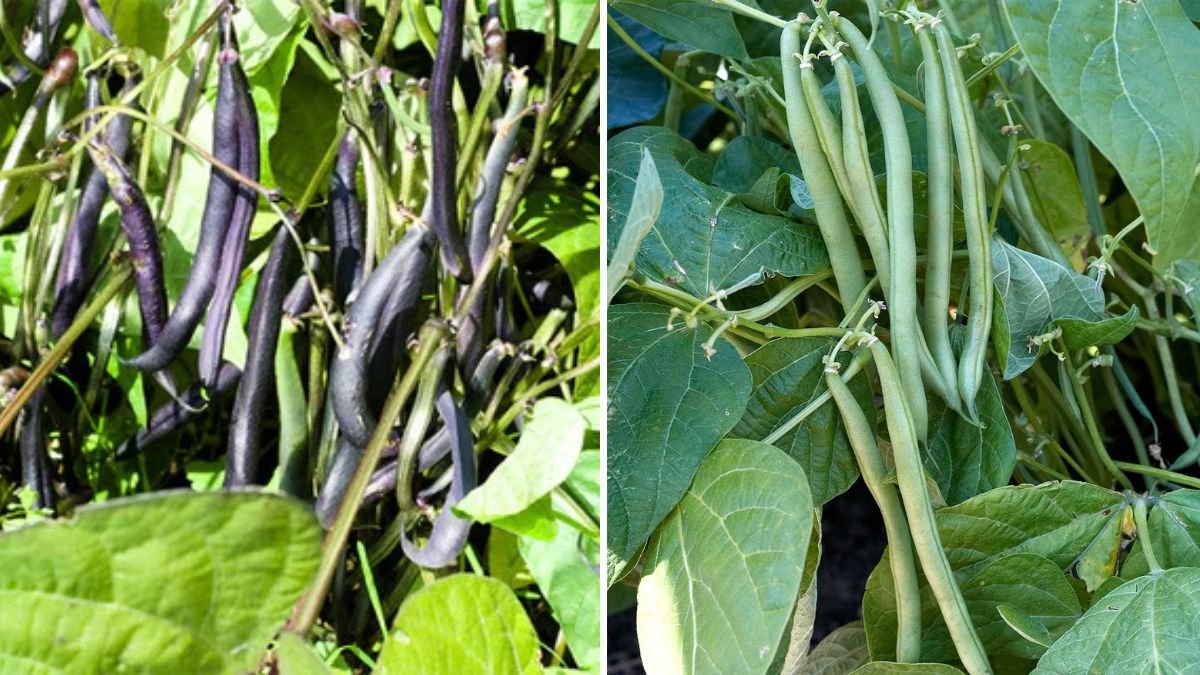Beans are a versatile, nutrient-rich, and easy-to-grow crop suitable for small spaces and container gardening. With the right approach, you can cultivate bountiful bean plants in pots, maximizing vertical space to increase yields while keeping your garden organized. Vertical bean gardening is perfect for balconies, patios, and urban environments where horizontal space is limited.
This guide explores choosing the right bean varieties, selecting containers, vertical support systems, planting techniques, care practices, and harvesting tips for successful vertical bean gardening in pots.
Why Grow Beans in Pots Vertically?
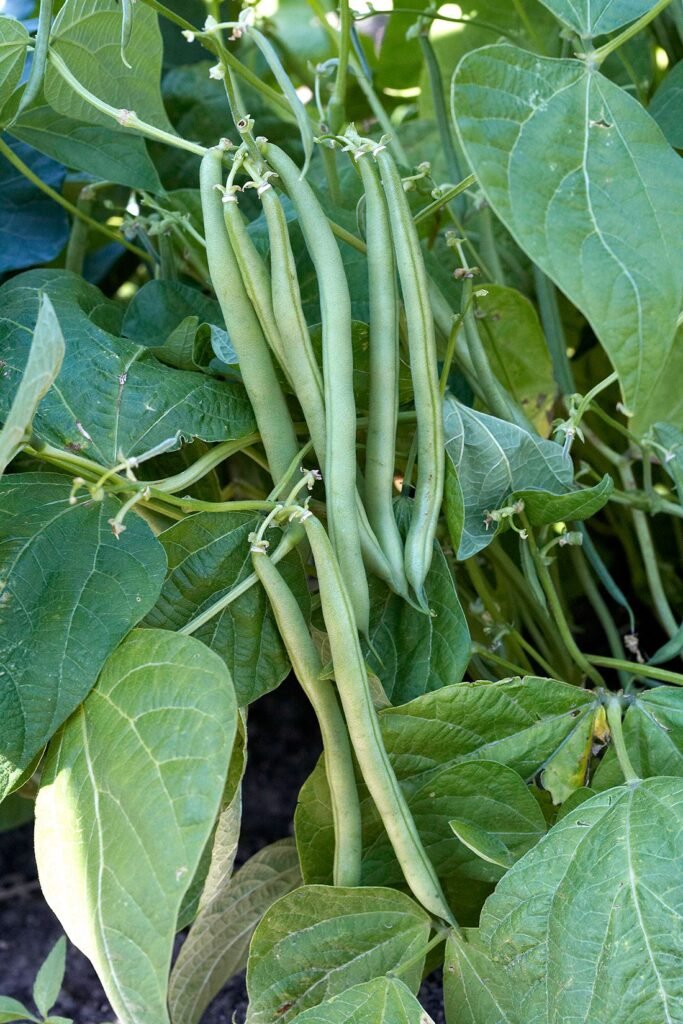
Growing beans vertically in containers has several advantages:
- Space Efficiency: Vertical growth allows gardeners to cultivate beans in tight spaces while maximizing productivity.
- Improved Air Circulation: Training plants upward reduces leaf crowding, minimizing fungal disease risk.
- Ease of Harvesting: Beans are easier to pick when hanging vertically, reducing the need to bend or reach into dense foliage.
- Higher Yields: Vertical training directs plant energy toward producing pods instead of sprawling leaves.
- Aesthetic Appeal: Vertical bean plants create a lush, green living screen, adding beauty and privacy to small spaces.
With vertical cultivation, gardeners can enjoy more beans in smaller areas with less effort.
Step 1: Choosing the Right Bean Varieties
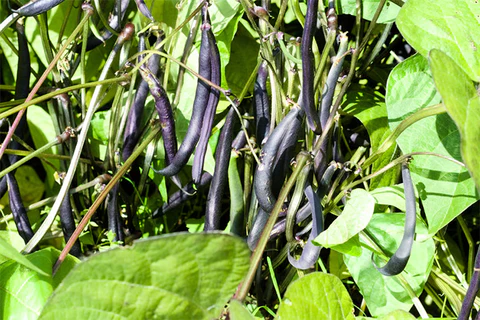
Bean types fall into two main categories, but not all are suited for vertical container growth:
- Pole Beans: Climbing varieties such as ‘Blue Lake’, ‘Kentucky Wonder’, and ‘Scarlet Runner’ are ideal for vertical growth. They produce abundant pods and benefit from trellises or stakes.
- Bush Beans: These compact varieties like ‘Provider’ and ‘Contender’ are better suited for small containers but do not climb. While they can be grown vertically with a small support, their height is limited.
For vertical gardening, pole beans are the preferred choice, as they naturally climb and produce continuously throughout the season.
Step 2: Selecting the Right Container
Container choice is crucial for healthy bean plants:
- Size: Beans need space for roots. Use pots at least 12–16 inches deep and 12–18 inches wide for one to two plants. Larger containers support multiple plants.
- Material: Plastic, ceramic, or wooden pots work, but ensure they are sturdy enough to support tall climbing plants.
- Drainage: Adequate drainage is essential. Drill extra holes if necessary to prevent waterlogging, which can cause root rot.
- Mobility: Consider lightweight or portable pots for adjusting light exposure or protecting plants from harsh weather.
Choosing the right container ensures strong root development and healthy vertical growth.
Step 3: Vertical Support Structures
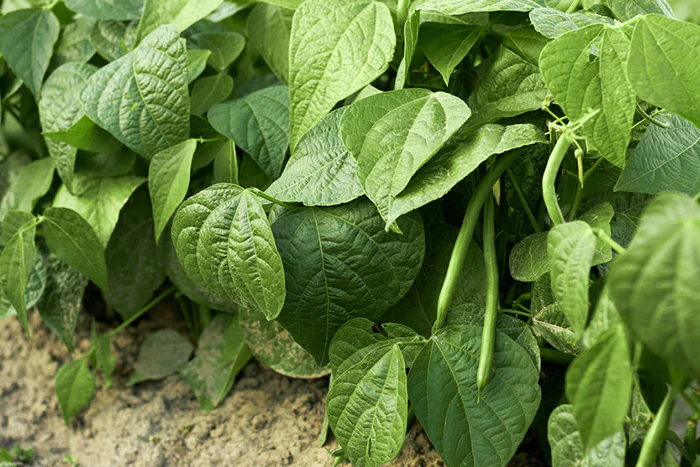
Vertical beans require strong supports for climbing:
- Trellises: Wooden or metal trellises provide sturdy vertical growth for beans. Ensure they are anchored securely in the container.
- Poles or Stakes: Bamboo, wooden stakes, or metal rods can be arranged in a teepee or single-pole configuration for support.
- String or Netting: Garden twine, nylon netting, or mesh provides flexible climbing surfaces for vines to attach.
- Tip: Place the support in the container at the time of planting to avoid disturbing roots later.
Proper vertical support prevents sprawling, improves air circulation, and maximizes sunlight exposure.
Step 4: Planting Beans in Pots
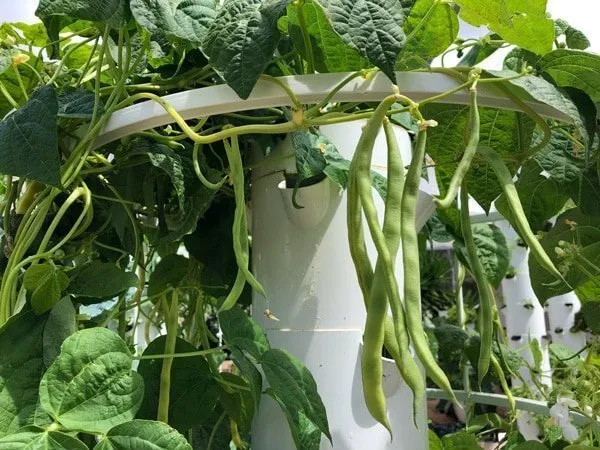
Correct planting technique ensures vigorous growth:
- Seed Preparation: Soak seeds overnight to accelerate germination. Choose fresh seeds for best results.
- Sowing Depth: Plant seeds 1–2 inches deep in moist, well-draining potting mix.
- Spacing: For pole beans, plant 2–3 seeds per pot and thin to the strongest seedling per position once sprouted.
- Soil Mix: Use a light, fertile mix with compost or aged manure to provide essential nutrients. Avoid heavy garden soil, which may compact in containers.
- Watering: Keep soil evenly moist during germination, but avoid waterlogging.
Proper planting sets the stage for healthy roots and strong climbing vines.
Step 5: Watering and Nutrient Management
Container-grown beans require consistent moisture and nutrient care:
- Watering: Beans need about 1 inch of water per week. Shallow container soil dries quickly; water when the top 1–2 inches feel dry. Water at the base to reduce leaf disease risk.
- Mulching: Organic mulch like straw or shredded leaves helps retain moisture and regulate soil temperature.
- Fertilization: Beans fix their own nitrogen, but adding a balanced fertilizer or compost at planting promotes healthy growth. Avoid excess nitrogen, which encourages foliage over pod production.
- Monitoring: Adjust water and feeding based on weather, growth stage, and container conditions.
Balanced watering and nutrition ensure steady vine growth and abundant pod production.
Step 6: Encouraging Vertical Growth
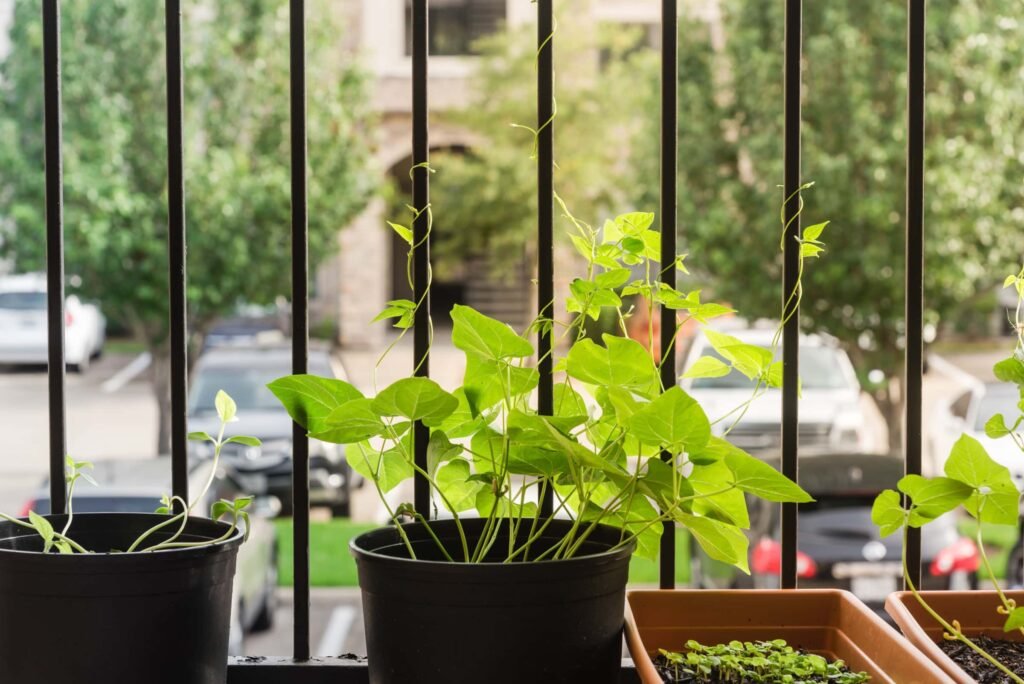
To maximize vertical yields:
- Training Vines: Gently wrap young tendrils around the trellis or support. Beans naturally climb, but guiding them ensures even coverage.
- Pruning: Minimal pruning is required; remove only dead or damaged leaves to improve airflow.
- Sunlight: Beans need 6–8 hours of full sun daily for optimal flowering and pod development. Rotate the container if sunlight is uneven.
- Pest Monitoring: Regularly check for aphids, spider mites, or leaf miners that can weaken vines. Use organic control methods when necessary.
Proper vine training ensures efficient vertical growth and healthier plants.
Step 7: Pollination and Flower Care
Healthy pod production requires flowers to be pollinated:
- Beans are primarily self-pollinating, but wind or insects can improve pod set.
- Gently shake or tap flowers to mimic natural pollination if growing indoors.
- Avoid excessive nitrogen, which can reduce flowering and pod production.
Good flower care ensures maximum bean yield from each vine.
Step 8: Harvesting Beans
Timely harvesting promotes continuous production:
- Pick Young and Tender Pods: Harvest beans when they are 4–6 inches long, before seeds bulge for the best texture and flavor.
- Frequent Harvesting: Regular picking encourages plants to produce more pods. Aim to harvest every 2–3 days during peak production.
- Avoid Damaging Vines: Use scissors or pinch pods carefully to prevent tearing stems.
- Storage: Fresh beans can be refrigerated for up to a week or blanched and frozen for longer storage.
Frequent and careful harvesting ensures continuous vertical productivity throughout the season.
Tips for Maximizing Vertical Bean Production
- Succession Planting: Sow new seeds every 2–3 weeks to maintain a continuous harvest.
- Companion Planting: Grow basil, marigold, or nasturtium nearby to deter pests naturally.
- Rotate Containers: Avoid planting beans in the same pot soil year after year to reduce disease buildup.
- Regular Inspection: Monitor for signs of pests, disease, or nutrient deficiency for early intervention.
- Support Maintenance: Ensure trellises or stakes remain stable as vines grow taller and heavier.
Attention to these details guarantees healthy plants and maximum pod yield.
Conclusion
Growing beans in pots for vertical harvests is a highly efficient and rewarding gardening method. By choosing the right bean variety, providing suitable containers and vertical supports, planting correctly, and maintaining proper watering, nutrition, and pest management, gardeners can enjoy abundant, fresh beans even in limited spaces.
Vertical cultivation not only maximizes space but also improves air circulation, reduces disease risk, and simplifies harvesting. With careful planning and regular attention, your container-grown beans will thrive, providing fresh, homegrown vegetables throughout the growing season.
Vertical bean gardening demonstrates that space limitations need not limit productivity—even a balcony, small patio, or urban rooftop can yield a generous harvest with the right techniques and care.
